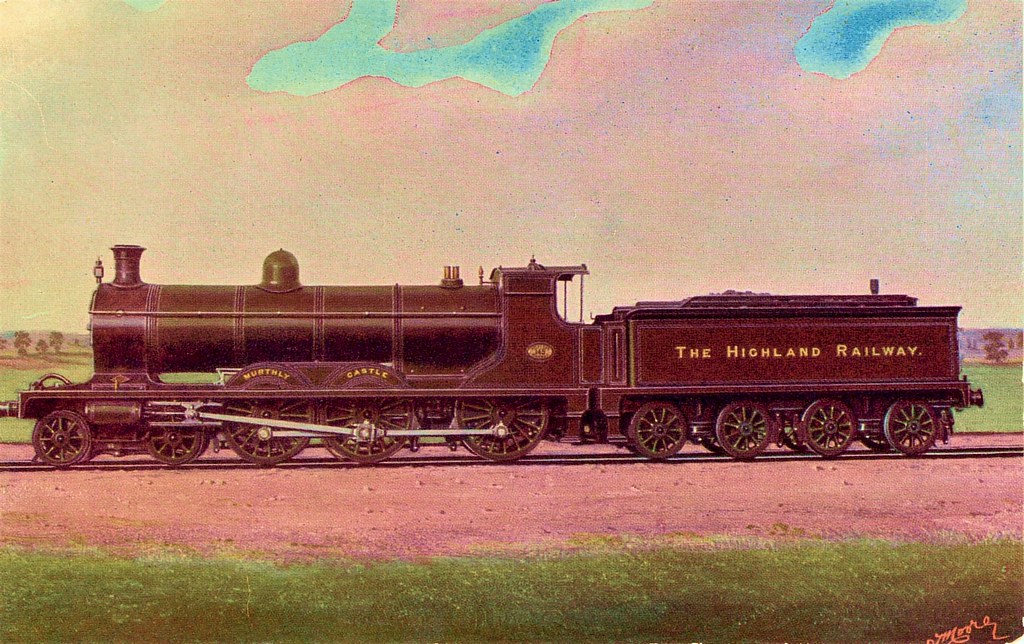#lm 1912
Text
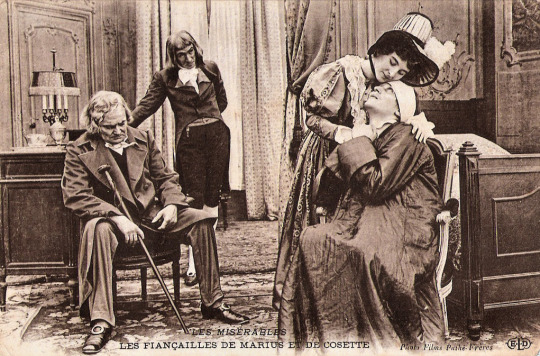
The betrothal of Marius and Cosette - Postcard advertising Les Misérables (1912) [source]
61 notes
·
View notes
Note
i'm working in an archive and i was going through a scrapbook from 1913/14 that had an advert for the les mis movie pasted in! made me happy that the person saw the movie and liked it enough to keep a record of it :)
GASP
that's so cool! Did you by any chance get to take a photo of it? Either way, yeah! I love knowing that people were so excited for a Les Mis movie back then, too :D
34 notes
·
View notes
Text
Strangers to Onself
Describe a random encounter with a stranger that stuck out positively to you.
The spirit of KALAGA
” Have never felt someone is a stranger though I might see their ways to be strange simply because, I get to understand almost everything about some one the very first time I see them.
Moreover, I decide who on planet Earth has the power to influence my life. So the question of things sticking…

View On WordPress
0 notes
Text

Cover art of the 1912 Polish edition of Anne of Green Gables (Ania z Zielonego Wzgórza) by LM Montgomery
full scan at Biblioteka Narodowa
11 notes
·
View notes
Text
James is a Libra. Change my mind.
And he canonically is in EoSR since his IRL basis, the actual LMS 12556, was built in October of 1912. So is his sister, LMS 12555, who was built in September of 1912.
*pretends that he isnt a Sagittarius, like Mattel has said*
#her train of thoughts#engines of sudrian rails by muxse#ttte james#he just screams Libra energy#ttte oc#eosr lms 12555 jasmine
6 notes
·
View notes
Text
Thomas and Friends Headcanons (The Famous Eight)
NWR #1-Thomas Billinton
Basis: LB&SCR E2 w/ extended side tanks
Designer: L.B. Billinton
Buildplace: Brighton, East Sussex, England
Backstory: Thomas was one of the last E2's to be designed. Built on September 1, 1915, he would first work as a station pilot. During this time, he was painted in the LB&SCR's black livery with red lining. His number was #106. He came to Sodor during WW1 due to a shortage of tank engines on the island.
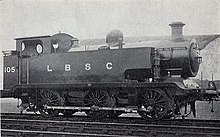
NWR #2-Edward Stewart-Pettigrew
Basis: heavily modified FR K2
Designer: W.F. Pettigrew
Buildplace: Springburn, Glasgow, Scotland
Backstory: Edward was one of the first K2's. Built on July 12, 1896, he would work for 9 years as an express engine near his build site before working in Cumbria until 1915, when he was sent to Sodor. During this time, he was painted in the FR's indian red livery with vermillion and black lining. His number was #37. Like Thomas, he came to Sodor due to a growing need for express engines.

NWR #3-Henry Gresley-Stanier
Basis: LNER A1/C1 hybrid (formerly) LMS Stanier Class 5 "Black 5" (currently)
Designer: Sir Nigel Gresley (old shape) Sir William Stanier (new shape)
Buildplace: Doncaster, South Yorkshire, England (old shape) Crewe, Cheshire, England (new shape)
Backstory: Around April 13, 1919, Henry was built from stolen blueprints of Sir Nigel Gresley by an unknown locomotive builder who held a grudge against Gresley. He hadn't realized that the blueprints were for an experimental locomotive. By the time he did, Henry had already been built. Along with many other problems, he had a small firebox, making him a poor steamer. The builder decided to sell Henry to the first available buyer, which was Sir Topham Hatt I. Due to his desperation for locomotives, Sir Topham Hatt had no choice but to keep Henry. When Henry arrived, he was painted in a special green livery with red stripes and had no number.
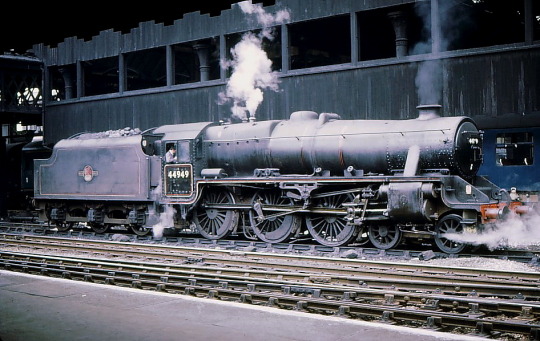
NWR #4-Gordon Gresley
Basis: LNER A1 Pacific
Designer: Sir Nigel Gresley
Buildplace: Doncaster, South Yorkshire, England
Backstory: Gordon was an experimental prototype for the A1 class, nicknamed the A0, built on February 20, 1922. Unlike his brothers and sisters, he was never given a number and only went out for test runs. He was sent to Sodor the next year due to the growing NWR's need for a premier express engine. When he arrived, he was painted in LNER black.

NWR #5-James Hughes
Basis-Modified L&YR Class 28
Designer: George Hughes
Buildplace: Horwich, Greater Manchester, England
Backstory: James was an experimental Class 28 with an extended pony truck and 5 ft 6 in driving wheels. Built on October 3, 1912, he worked for 12 years as a mixed-traffic engine. During this time, he was painted in the L&YR's black livery with red and white lining. His number was 52529. He was sent to Sodor to help with both passengers and freight.

NWR#6 Percival 'Percy' Avonside
Basis-GWR Trojan prototype
Designer: Avonside Engine Company
Buildplace: St. Phillip's, Bristol, England
Backstory: Percy was an experimental prototype of the GWR Trojan. At some point in his life, he received Hunslet components. Built on June 3, 1900, he worked for the GWR for 25 years as a station pilot. During this time, he was painted in the GWR's Middle Chrome Green livery with yellow lining. Soon after, he was put in a workshop, where he was bought by Sir Topham Hatt and sent to Sodor.

NWR #7-Tobias 'Toby' Holden
Basis- GER Class C53/LNER Class J70
Designer: James Holden
Buildplace: Stratford, London, England
Backstory: Toby was one of the last C53's built. Built on September 15, 1914, he would work at the Wisbech and Upwell Tramway as a mixed-traffic engine. He was numbered 62553. One summer in 1951, Sir Topham Hatt I, along with his wife, Lady Hatt, and grandchildren Bridget, Stephen, and Gerald, went to East Anglia for a holiday, and met Toby on the tramway. They liked him a lot, and the feeling was mutual. Later, when Thomas got in trouble, Sir Topham Hatt remembered Toby and brought him from his old railway after it had closed down. When Toby arrived on Sodor, he was painted in the LNER's brown livery with black sideplates with yellow LNER lettering on them.
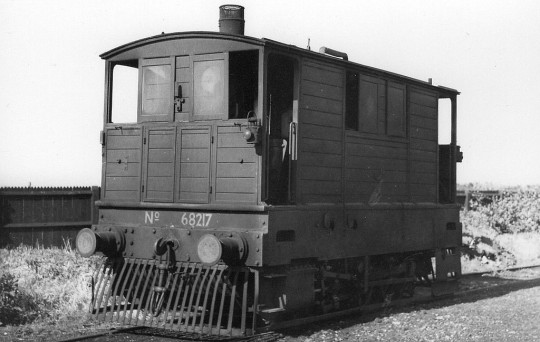
NWR #8-Montague 'Duck' Collett
Basis-GWR 5700 Class
Designer: Charles Collett
Buildplace: Springburn, Glasgow, Scotland
Backstory: Duck was one of the last 5700's built. Built on August 17, 1929, he would work at Paddington as a station pilot. He was numbered 5743. In 1955, Knapford was in need of a new station pilot, so Duck was sent over to Sodor. When he arrived, he was painted in BR black.
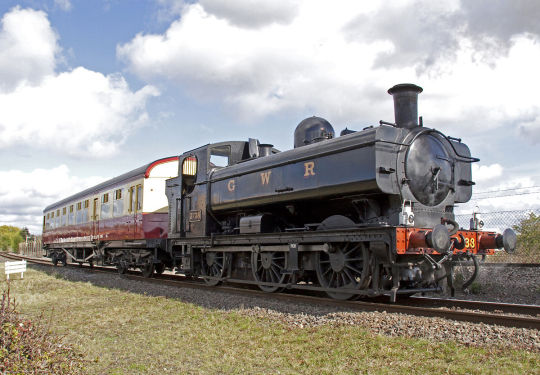
2 notes
·
View notes
Text
L&YR Class 28
The Lancashire and Yorkshire Railway or L&YR, class 28 was designed by George Hughes. the class was a rebuild of Sir John Audley Frederick Aspinall's Class 27, built from 1909 to 1912, with 20 new-builds and 63 rebuilt from class 27 with 83 Total. with a Whyte of 0-6-0, this class of standard gauge loco’s would be given to the London and North Western Railway (LNWR) in 1922 and passed on to the London, Midland and Scottish Railway (LMS) in 1923. in 1948, the 35 surviving locomotives passed on to British Railways (BR). the class was withdrawn from 1936 to 1957 and were all scrapped.

in Thomas and friends James the splendid red engine is bassed off of this class.
3 notes
·
View notes
Text
Events 1.1 (between 1830-1940)
1822 – The Greek Constitution of 1822 is adopted by the First National Assembly at Epidaurus.
1834 – Most of Germany forms the Zollverein customs union, the first such union between sovereign states.
1845 – The Philippines began in sync with Asian dates by redrawing the International Date Line through skipping Tuesday, December 31, 1844. Ordered by Governor–General Narciso Claveria reforming the country calendar to align with the rest of Asia. It's territory was one day behind for 323 years since the arrival of Ferdinand Magellan in the Philippines on March 16, 1521.
1847 – The world's first "Mercy" Hospital is founded in Pittsburgh, United States, by a group of Sisters of Mercy from Ireland; the name will go on to grace over 30 major hospitals throughout the world.
1860 – The first Polish stamp is issued, replacing the Russian stamps previously in use.
1861 – Liberal forces supporting Benito Juárez enter Mexico City.
1863 – American Civil War: The Emancipation Proclamation takes effect in Confederate territory.
1877 – Queen Victoria of the United Kingdom is proclaimed Empress of India.
1885 – Twenty-five nations adopt Sandford Fleming's proposal for standard time (and also, time zones).
1890 – Eritrea is consolidated into a colony by the Italian government.
1892 – Ellis Island begins processing immigrants into the United States.
1898 – New York, New York annexes land from surrounding counties, creating the City of Greater New York. The four initial boroughs, Manhattan, Brooklyn, Queens, and The Bronx, are joined on January 25 by Staten Island to create the modern city of five boroughs.
1899 – Spanish rule ends in Cuba.
1900 – Nigeria becomes British protectorate with Frederick Lugard as high commissioner.
1901 – The Southern Nigeria Protectorate is established within the British Empire.
1901 – The British colonies of New South Wales, Queensland, Victoria, South Australia, Tasmania, and Western Australia federate as the Commonwealth of Australia; Edmund Barton is appointed the first Prime Minister.
1902 – The first American college football bowl game, the Rose Bowl between Michigan and Stanford, is held in Pasadena, California.
1910 – Captain David Beatty is promoted to Rear admiral, and becomes the youngest admiral in the Royal Navy (except for Royal family members) since Horatio Nelson.
1912 – The Republic of China is established.
1914 – The SPT Airboat Line becomes the world's first scheduled airline to use a winged aircraft.
1923 – Britain's Railways are grouped into the Big Four: LNER, GWR, SR, and LMS.
1927 – A new Mexican oil legislation goes into effect, leading to the formal outbreak of the Cristero War.
1928 – Boris Bazhanov defects through Iran. He is the only assistant of Joseph Stalin's secretariat to have defected from the Eastern Bloc.
1929 – The former municipalities of Point Grey, British Columbia and South Vancouver, British Columbia are amalgamated into Vancouver.
1932 – The United States Post Office Department issues a set of 12 stamps commemorating the 200th anniversary of George Washington's birth.
1934 – Alcatraz Island in San Francisco Bay becomes a United States federal prison.
1934 – A "Law for the Prevention of Genetically Diseased Offspring" comes into effect in Nazi Germany.
0 notes
Text
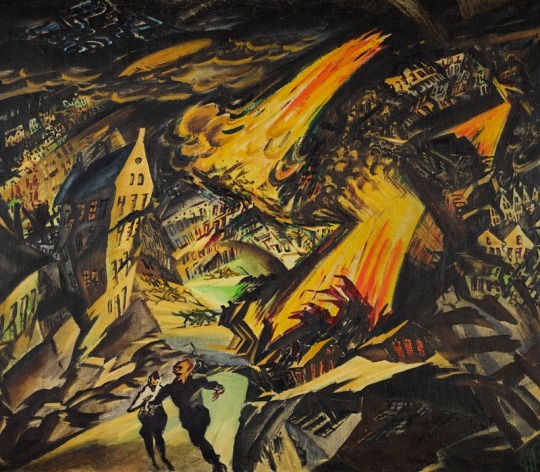
Ludwig Meidner (1884 - 1966), Apokalyptische Landschaft (Apocalyptic Landscape). Signed with the initials LM and dated 1912
Courtesy Alain Truong
24 notes
·
View notes
Text
My Model Locomotive Collection 2019
AKA; Locomotives Currently Stationed At Taddlecombe Junction Shed For Use On Both Main and Branch Line Services

LNER A4 No. 4468 Mallard
Built: 3 March 1938, Doncaster Works
Designer: Sir Herbert Nigel Gresley
Withdrawn: 25 April 1963
Fate: Preserved in the National Collection at York
Condition of Model: As built (1938)
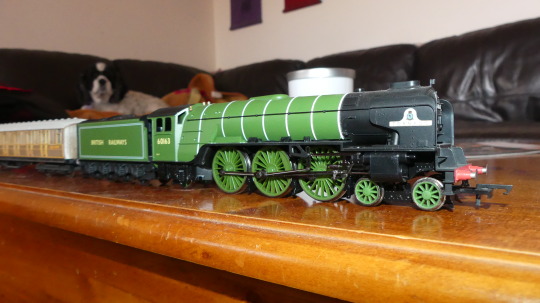
BR Peppercorn A1 No. 60163 Tornado
Built: 1 August 2008, Darlington Works
Designer: Arthur Peppercorn/A1 Locomotive Trust
Withdrawn: N/A
Fate: Operational on main line
Condition of Model: As built (2008)
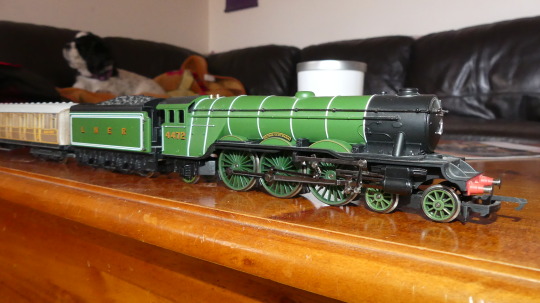
LNER Gresley A1 No. 4472 Flying Scotsman
Built: February 1923, Doncaster Works
Designer: Sir Herbert Nigel Gresley
Withdrawn: 15 January 1963
Fate: Preserved in the National Collection at York
Condition of Model: c. 1928 condition
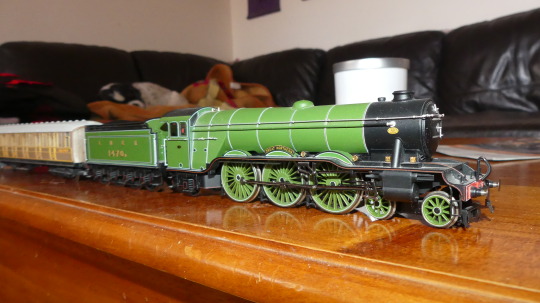
LNER A1 No. 4470 Great Northern
Built: April 1922, Doncaster Works (by the Great Northern Railway)
Designer: Sir Herbert Nigel Gresley
Withdrawn: Rebuilt 1945 as Thompson A1/1, withdrawn November 1962
Fate: Scrapped
Condition of Model: 1923 livery.
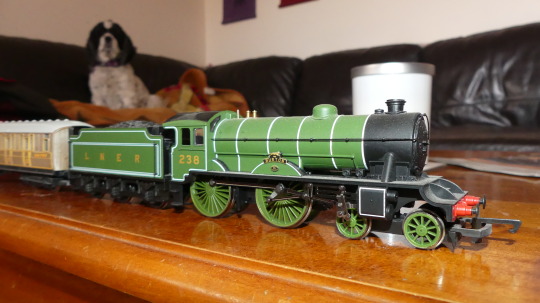
LNER D49/2 ‘Hunt’ No. 238 The Burton
Built: August 1934, Darlington Works
Designer: Sir Herbert Nigel Gresley
Withdrawn: December 1957
Fate: Scrapped
Condition of Model: As built (1934)
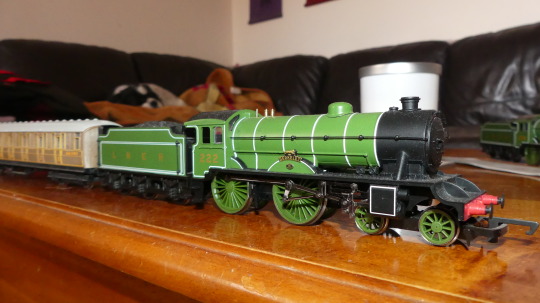
LNER D49/2 ‘Hunt’ No. 222 The Berkeley
Built: July 1934, Darlington Works
Designer: Sir Herbert Nigel Gresley
Withdrawn: November 1959
Fate: Scrapped
Condition of Model: As built (1934)
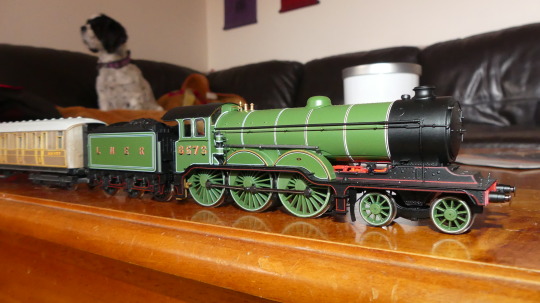
LNER B12/3 No. 8573
Built: August 1928, Beyer Peacock & Co.
Designer: S.D Holden/Sir Herbert Nigel Gresley
Withdrawn: January 1959
Fate: Scrapped
Condition of Model: As built (1928)
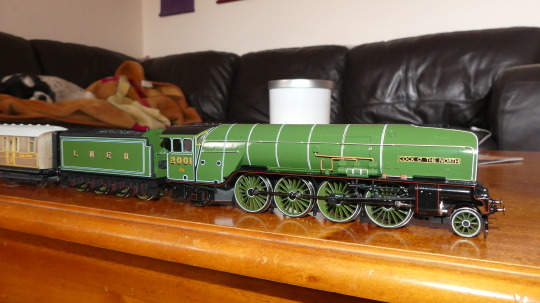
LNER P2 No. 2001 Cock O’ The North
Built: May 1934, Doncaster Works
Designer: Sir Herbert Nigel Gresley
Withdrawn: Rebuilt 1944 as Thompson A2/2, withdrawn February 1960
Fate: Scrapped
Condition of Model: As built (1934)

British Railways 7P ‘Britannia’ No. 70036 Boadica
Built: December 1952, Crewe Works
Designer: R. A. Riddles
Withdrawn: October 1966
Fate: Scrapped
Condition of Model: As built (1952)

British Railways 9F No. 92220 Evening Star
Built: March 1960, Swindon Works
Designer: R. A. Riddles
Withdrawn: March 1965
Fate: Preserved in the National Collection at York
Condition of Model: As present

British Railways A4 No. 60033 Seagull
Built: June 1938, Doncaster Works (by the LNER)
Designer: Sir Herbert Nigel Gresley
Withdrawn: December 1962
Fate: Scrapped
Condition of Model: Late 1950s/Early 1960s
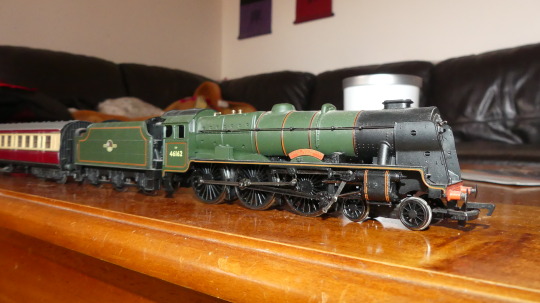
British Railways Rebuilt Royal Scot No. 46162 Queen’s Westminster Rifleman
Built: September 1930, Derby Works (by the LMS)
Designer: Sir Henry Fowler/Sir William Stanier
Withdrawn: May 1964
Fate: Scrapped
Condition of Model: Late 1950s/Early 1960s

British Railways D49/2 No. 62760 The Cotswold
Built: September 1934, Darlington Works (for the LNER)
Designer: Sir Herbert Nigel Gresley
Withdrawn: October 1959
Fate: Scrapped
Condition of Model: Early 1950s
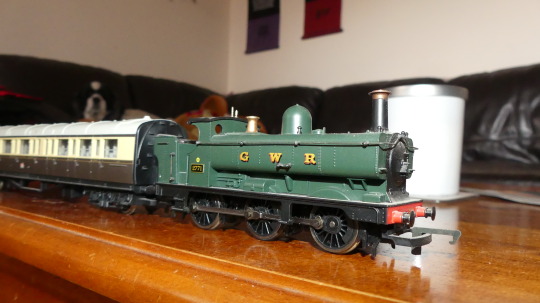
Great Western Railway 2721-class No. 2771
Built: September 1900, Swindon Works
Designer: William Dean
Withdrawn: June 1950
Fate: Scrapped
Condition of Model: 1920s/30s
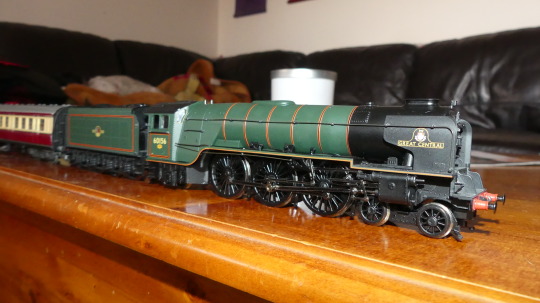
British Railways Peppercorn A1 No. 60156 Great Central
Built: October 1949, Doncaster Works
Designer: Arthur Peppercorn
Withdrawn: May 1965
Fate: Scrapped
Condition of Model: Late 1950s/Early 1960s
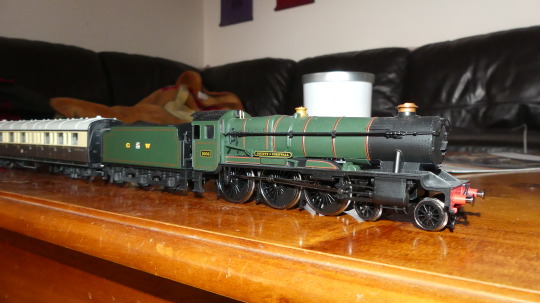
Great Western Railway County-class No. 1006 County of Cornwall
Built: November 1945, Swindon Works
Designer: Frederick Hawksworth
Withdrawn: September 1963
Fate: Scrapped
Condition of Model: As built (1945)
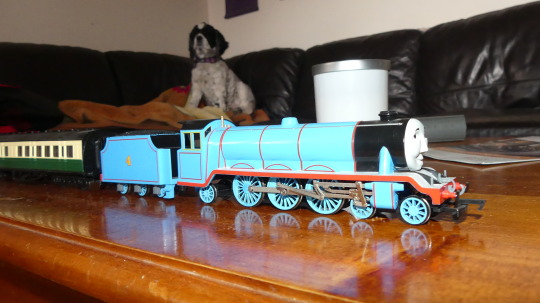
North Western Railway Modified A1 No. 4 Gordon
Built: 1922, Doncaster Works
Designer: Sir Herbert Nigel Gresley/Sir Topham Hatt
Withdrawn: N/A
Fate: In service
Condition of Model: As present

North Western Railway Modified Class 28 James
Built: c. 1912, Horwich Works
Designer: George Hughes/Sir Topham Hatt
Withdrawn: N/A
Fate: In service
Condition of Model: As present
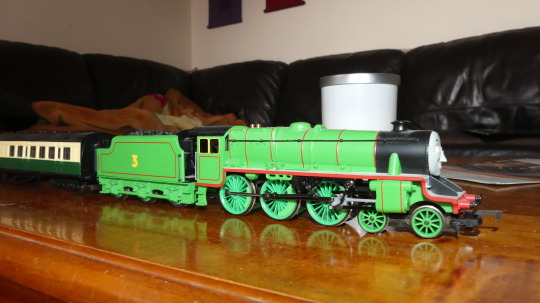
North Western Railway 5MT No. 3 Henry
Built: 1922, Derby Works
Designer: Sir William Stanier
Withdrawn: N/A (rebuilt as 5MT in 1935 at Crewe Works)
Fate: In service
Condition of Model: As present
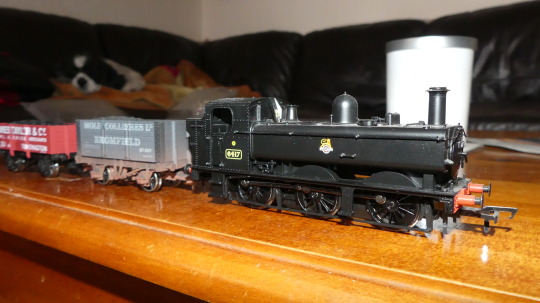
British Railways 6400-class No. 6417
Built: December 1934, Swindon Works (for the GWR)
Designer: Charles Collett
Withdrawn: June 1959
Fate: Scrapped
Condition of Model: Early 1950s

Southern Railway Q1 No. C21
Built: June 1942, Ashford Works
Designer: Oliver Bulleid
Withdrawn: August 1963
Fate: Scrapped
Condition of Model: As built (1942)
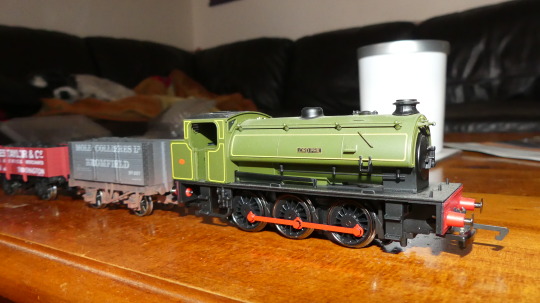
Peak Rail Austerity Lord Phil
Built: 1943, Hunslet (for the War Department)
Designer: R. A. Riddles
Withdrawn: 1980s?
Fate: Preserved by Peak Rail
Condition of Model: As present

LNER J94 (Austerity) No. 8009
Built: March 1944, Hunslet (for the War Department)
Designer: R. A. Riddles
Withdrawn: July 1962
Fate: Scrapped
Condition of Model: c. 1946

Totally Fictitious Hornby Railroad 0-4-0
Built: It wasn’t
Designer: Hornby
Withdrawn: N/A
Fate: N/A
Condition of Model: pretty
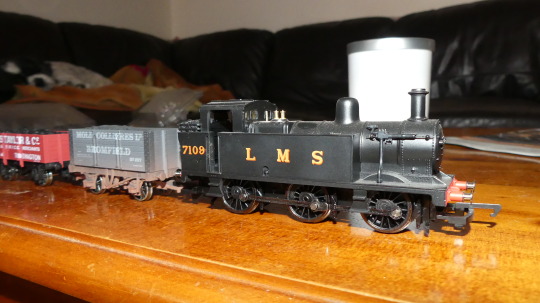
LMS 3F Jinty No. 7109
Built: July 1924, Vulcan Foundry
Designer: Sir Henry Fowler
Withdrawn: September 1962
Fate: Scrapped
Condition of Model: As built (1924)
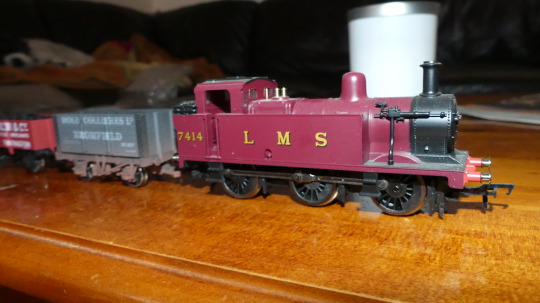
LMS 3F Jinty No. 7414
Built: December 1926, Vulcan Foundry
Designer: Sir Henry Fowler
Withdrawn: May 1962
Fate: Scrapped
Condition of Model: 1930s (livery fictional?)
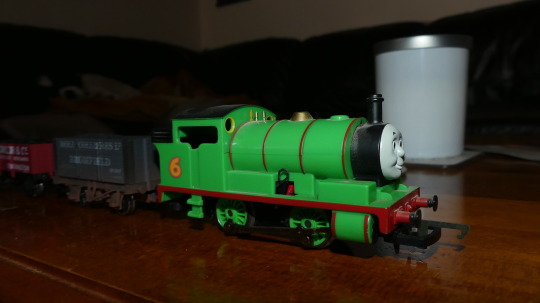
North Western Railway Avonside No. 6 Percy
Built: c. 1950, Avonside Works
Designer: Avonside
Withdrawn: N/A
Fate: In service
Condition of Model: As present
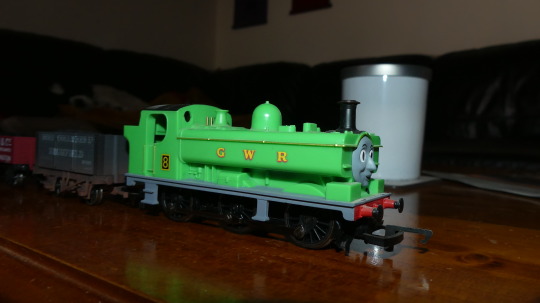
North Western Railway 5700-class No. 8 Montague (’Duck’)
Built: c. 1930, Swindon Works
Designer: Charles Collett
Withdrawn: N/A
Fate: In service
Condition of Model: As present

Sodor China Clay Works No. 2 Ben
Built: 1953, W. G Bagnall
Designer: W. G. Bagnall
Withdrawn: N/A
Fate: In service
Condition of Model: As present
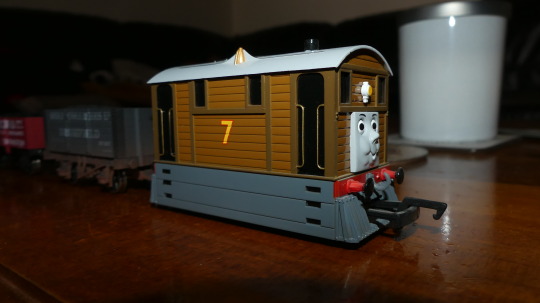
North Western Railway J70 No. 7 Toby
Built: 1903, Stratford Works
Designer: James Holden
Withdrawn: N/A
Fate: In service
Condition of Model: As present
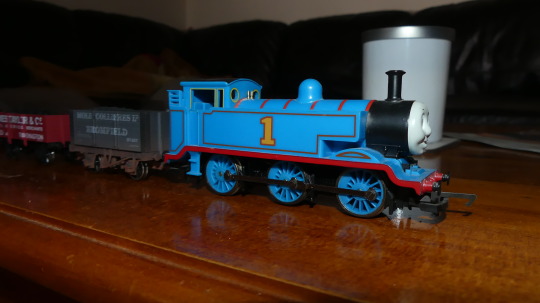
North Western Railway Modified E2 No. 1 Thomas
Built: c. 1916, Brighton Works
Designer: Lawson Billington/Sir Topham Hatt
Withdrawn: N/A
Fate: In service
Condition of Model: As present

LMS Caledonian Single No. 14010
Built: 1886, Neilson & Co.
Designer: Dugald Drummond
Withdrawn: 1935
Fate: Displayed in the Riverside Museum in Glasgow
Condition of Model: As in 1935
30 notes
·
View notes
Text

Still from Les Misérables (1912), directed by Albert Capellani and produced for Pathé-Frères by the Société cinématographique des auteurs et gens de lettres [source]
28 notes
·
View notes
Photo

요즘 학습 관리 시스템도 스마트하게!
그 동안은 훈련생 분들이 수강 시간표나 평가에 대해 알려고 하면
직접 학교 행정팀에 문의하거나 게시판을 찾아봤어야했는데요,
이러한 불편함을 줄이고 보다 체계적인 훈련생 관리를 위한 LMS 시스템을 도입하고자
'원격 lms 시스템 도입 설명회' 에 부산예일직업전문학교 교직원들이 참가하여
훈련생 분들이 편리하고 정확한 정보를 얻을 수 있도록
다양한 LMS시스템을 비교하고 알아보는 시간을 가졌습니다 :)
얼른 편리하고 다루기 쉬운 LMS 시스템을 도입하여 훈련생 분들의 쾌적한 훈련 환경 조성을 위하여 늘 노력하는 부산예일직업전문학교가 되겠습니다!
▶ 직업훈련 과정 접수 및 문의
(무역물류, 게임그래픽, 게임프로그래밍, 편집디자인(포토샵,일러스트,인디자인), 직업상담사, 전산회계 등)
- Tel : 051 - 467 - 1912
- 카카오톡 '부산예일직업전문학교' 검색
- 교육, 상담장소 : 부산진구 중앙대로 631 (선문빌딩 5, 9층)
자세한 내용은 홈페이지에서 확인하세요!
과정일정 -> www.yeilit.com
0 notes
Text
Paßmann-Villa erregt Aufsehen
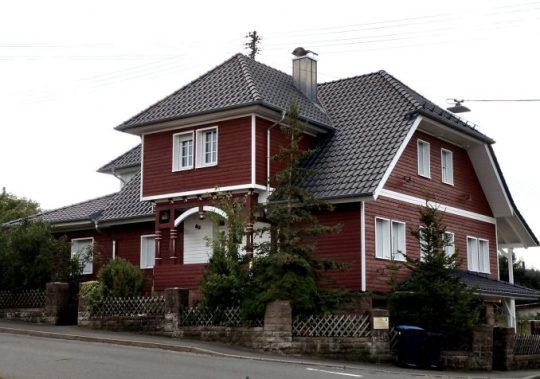
_Die Paßmann-Villa in Langenelz. (Foto: Liane Merkle)_
## Langenelz erinnert an Ehrenbürger
**Langenelz.** _ (lm) _Ein Gebäude, das bisher eher übersehen wurde, erregt in den letzten Monaten zunehmend Aufsehen in Langenelz. Denn inzwischen erstrahlt die Außenfassade und die unglaublich vielen und vielfältigen Dächer an diesem Prunkbau in unübersehbar neuem und vor allem sehr stimmigen neuen Glanz. Es ist die Rede von der ehemaligen „Paßmann-Villa“, die 1921 – also vor fast 100 Jahren beachtlich kleiner erbaut worden war.
Hans Slama, 1. Vorsitzender der Mudauer Heimat- und Verkehrsvereins, erinnerte sich schon vor der Renovierung an den Ehrenbürger von Langenelz und Mudau, Herrmann Paßmann, und initiierte eine Gedenktafel, die dieser Tage am Gartenzaun des Gebäudes Im Beisein der jetzigen Hauseigentümer, Bürgermeister Dr. Norbert Rippberger und Ortvorsteher Markus Späth angebracht und übergeben wurde.
Die Tafel informiert „zur Erinnerung an Ehrenbürger Herrmann Paßmann: Der Langenelzer Ehrenbürger und Handeslmann Herrmann Paßmann aus Duisburg, wohnte in diesem Haus, das er 1927 ersteigerte. Er war bereits seit 1912 Jagdpächter in Oberneudorf, dann auch von 1928 bis 1945 in Langenelz. Herrmann Paßmann unterstützte die Bevölkerung hauptsächlich finanziell, insbesondere die Schule.
Deshalb beschloss der Gemeinderat am 20.
#BürgermeisterDrNorbertRippberger #HVVMudau #Langenelz #Slider
Lesen Sie den ganzen Artikel
0 notes
Video
Highland Railway (UK) - HR Class A (Castle Class) 4-6-0 steam locomotive Nr. 145 "Murthly Castle" (Dübs Locomotive Works, Glasgow 3853 / 1910) by Historical Railway Images
Via Flickr:
Highland Railway Class A steam locomotive Nr. 145 was designed by Peter Drummond, the railway's locomotive superintendent between 1896 and 1912. Nineteen such locomotives were built for the Highland Railway by Dübs of Glasgow and later on, by the North British Locomotive Company, from 1900 to 1917. They became LMS Class 3P Nrs. 14675–14693.
0 notes
Text
How to Check a Louis Vuitton Serial Number
New Post has been published on https://www.vivrelereve.co.uk/how-to-check-a-louis-vuitton-serial-number/
How to Check a Louis Vuitton Serial Number
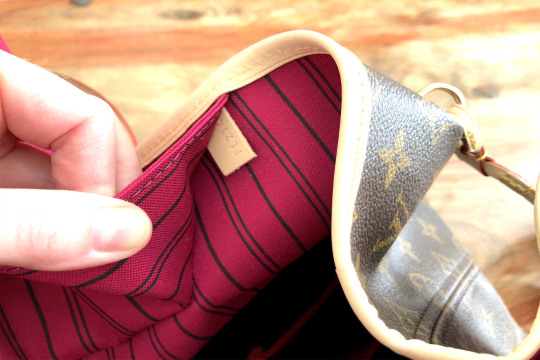
How to Check a Louis Vuitton Serial Number
Did you know that you can learn a lot about a Louis Vuitton bag’s origin by looking at its date code? It is the key to finding out when and where a piece was manufactured. When you are shopping for a vintage Louis Vuitton, one of the first things you’ll want to look for is the date code. Unlike other designer brands, Louis Vuitton is unique in that each bag is marked with specific information about exactly where and when it was produced.
Louis Vuitton has been placing date codes in almost every newly manufactured bag, wallet and SLG since the early 1980s. Sometimes date codes are hidden and may be difficult to find, but in most cases they are visibly stamped on the lining or onto an attached tag.
Louis Vuitton has changed the date code configuration multiple times, but the date code will always contain letters and/or numbers. The date code on a Louis Vuitton tells the country and date of origin for a bag. Depending on the year of production the date code will contain a different variation of letters and/or numbers. While all Louis Vuitton bags have date codes you must remember that it alone does not tell you if a bag is authentic. It is merely just one piece of the puzzle.
Before 1982
No date codes. Louis Vuitton did not use date codes before 1982, therefore older vintage pieces can not be pinpointed as accurately as newer ones.
1982 to Mid 1980s
Three / four digit date codes. Vuitton’s first usage of dates codes began in 1982. These codes consist of three to four digit numbers, and no letters. The first two numbers indicate the year, and the last one or two numbers indicate the month.
Mid to Late 1980s
Three / four digit date codes with two letters. Louis Vuitton changed the date code system in the 1980s. To include letters that indicate the factory where pieces were manufactured. Like in the early 1980s, the first two numbers indicate the year. And the last one or two numbers indicate the month.
1990 to 2006
Date codes with two letters and four digits. Early in 1990, Louis Vuitton moved the factory letters to the front and revised the numbering on its date codes. The first and third numbers represent the month, and the second and fourth numbers represent the year. For example, TH 1912 is November 1992
2007 to Present Day
Two letters and four digits. In 2007, Louis Vuitton changed the four digit numbering system. Instead of indicating the month an item was manufactured, the first and third numbers now represent the week. The second and fourth numbers still represent the year. The letters continued to represent the specific factory where the item was manufactured. After almost two decades of one date code formatting. With just a slight change, they started tracking by week instead of the month. Instead of knowing that your bag was made in France in May. You can now know that your bag was made in the 20th week of that year. For example, TH 2059 is 25th week of 2009
Louis Vuitton Date Code Factory Chart – By Country
Tracking the country of origin on your Louis Vuitton is done by using two simple letters. Now, there are many exceptions to country codes. While not a conclusive list, here are the date codes and the country of origin they typically represent on a Louis Vuitton handbag.
France A0, A1, A2, AA, AH, AN, AR, AS, AX, BA, BJ, BU, CT, CV, DR, DU, ET, FL, GR, IT, LW, MB, MS, MI, NO, RA, RE (also Italy), RI, SA (also Italy), SD (also USA), SF, SL, SN, SP, SR, TA, TH, TJ, TN, TR, TS, VI, V.I. Germany LP, OL Italy BO, CE, FA, FO, RE, MA, NQ, PL, RC, RO, SA (also France), ST, TD, LE USA FC, FH, OS, SD (also France), LA, Spain CA, CR, GI, LB, LM, LO, LW Switzerland DI, FA (also Italy)
#check your louis vuitton serial number#enter louis vuitton date code#louis vuitton authenticity check#louis vuitton date code purseforum#louis vuitton no date code#louis vuitton serial number checker#louis vuitton serial number location#louis vuitton serial number lookup
0 notes
Text
11/16/19 EECS Balloon, Day - 4 "Toto, I've a feeling we're not in Kansas anymore"
Hi All —
Link: https://aprs.fi/#!mt=roadmap&z=7&call=a%2FNU6XB-11&timerange=604800&tail=604800
Last night our balloon traveled through Kansas, and crossed the entire state of Missouri. The Balloon woke upto a new day sun at 5:41am PST and immediately cross the great Mississippi River exactly at the corner of Kentucky Missouri and Tennessee. From there on, the Balloon travelled leisurely at 20-25MPh in south-east direction keeping a steady altitude between 20,000-21,500 feet. Last packet was transmitted at 1:57pm PST from about 60 miles south of Nashville.
We expect the balloon to cross the Smokey mountains tonight and enter Georgia, or even perhaps South Carolina.
For those who are interested in some background history, our Balloon callsign is NU6XB, (or the new 6XB) which is the callsign of the EECS amateur radio station in Cory Hall. The call sign 6XB was issued in 1914 for the University of California for an Experimental Special Land Station - and Amateur Station.
In 1913 the Shack and radio laboratory were stations in the Mechanics Building. These facilities were established by three senior students who taught the Berkeley professors about radio technology, not the other way around. This somewhat concluded activities these students had started in their teens. Beginning in 1905 they operated strong transmitters from their homes and formed in 1907 the Bay Counties Wireless Telegraph Association. Karl H. von Wiegand describes in his 1908 article "Stop it Kid!" how these activities triggered the first legislation about broadcasting. Our three founding members are:
Frank Rieber (1891-1948), 6XR in Berkeley, UCB Physics degree 1914. His inquiring mind and rebel tendencies led to a number of quasi-scientific experiments as introducing skunkboms into the ventilator system of the auditorium during a disciplinary assembly called by the Dean. Became a geophysicist, inventer and entrepreneur, who developed seismic measurement equipment.
Lewis Mason Clement (1892-1979), 6XC in Oakland (later K3AA, K4UR, K4UV), UCB EE degree 1914. Wireless operator on the Alaska coastal steemer S. S. Spokane when it sank in 1911. First person to talk by voice from an airplane (JN 4 Curtis Jenny) to ground in 1917.
Haraden W. Pratt (1891-1969), San Francisco - UCB EE degree 1914. He was an avid amateur operator using a 8KW spark transmitter from Lombard St, San Francisco (call letters S.K.H.). In 1912 he quitted after the law was introduced that limited amateurs to 200 meters and down and to less than 1KW transmit power. He became telecommunication advisor of presidents Truman and Eisenhauer.
1914: First documented activity of 6XB club members (article in the Oakland Tribune of Jan 1914, figure 1 below). Senior students LM Clement and HW Pratt flung up an antenna wire from the chimney of the Mechanics building to the bell tower construction site and succeeded in establishing wireless communication with the NAA station in Arlington.
Source: https://www.qrz.com/db/W6BB
0 notes
